While you are here – please check out my home page!
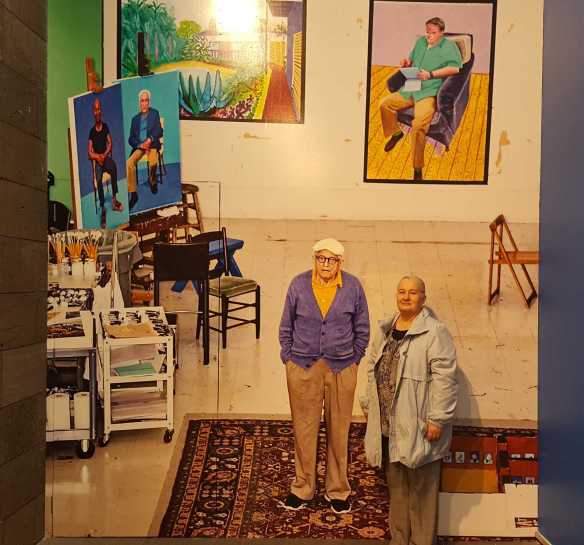
39 David Hockney Current Exhibition at National Gallery Victoria, Melbourne, Australia – Nov 2016. The gallery had provided a huge life-size photo image applied to a wall, featuring David Hockney standing in his studio. Visitors of the gallery were then able to stand beside the image of David Hockney and have their photo taken. The security guard at the gallery kindly offered to take a photo of me with David Hockney’s image which was very nice of him. Photographed by Security Guard at the National Gallery of Victoria.
INTRODUCTION
For our very last CAE ‘Produce Paintings & Drawings’ class, we were taken to the National Gallery of Victoria, Melbourne, Australia to see David Hockney’s latest solo exhibition titled ‘CURRENT’. He is arguably Britain’s greatest living artist and in his seventy-ninth year! Despite Hockney’s years, he still looks for new ways to take risks which are driven by his unending curiosity (NGV 2016). Viewing this exhibition proved to be a wonderful experience which I enjoyed very much, and was grateful for being given the opportunity to view. The exhibition consisted of over 1200 works including paintings, digital drawings, photography and video works by David Hockney.

1 David Hockney Current Exhibition at National Gallery Victoria Nov 2016. Photographed by Karen Robinson
DAVID HOCKNEY REFLECTS ON THE EXHIBITION – CURRENT
The YouTube here below has David Hockey talking about this exhibition at the National Gallery of Victoria being the first show that really exhibits the iPads and the iPhones work he had created. He states that he got the ‘brushes app’ process working quickly and well; and how much he enjoys using these new pieces of technology to produce art work. He also talks about his creative processes used to produce this exhibition (NGV 2016).
DAVID HOCKNEY – SELECTED iPHONES AND iPAD DRAWINGS
Viewing David Hockney’s ‘selection of 104 drawings using an iPhone 2009 and iPad 2010-12, comprising still life, landscape and portrait works’ (NGV 2016) was truly amazing, and for me – very enjoyable. I loved seeing how these technologies produced a selection of work that was considered most worthy of such a prestigious exhibition; and by such a famous, well established and masterful artist. So good for up-and-coming tech savvy artists!

3 David Hockney Current Exhibition at National Gallery Victoria Nov 2016. iPhone & iPad drawings by David Hockney. Photographed by Karen Robinson

6 David Hockney Current Exhibition at National Gallery Victoria Nov 2016 Photographed by Karen Robinson

12 David Hockney Current Exhibition at National Gallery Victoria Nov 2016. iPhone and iPad drawings by David Hockney. Photographed by Karen Robinson

7 David Hockney Current Exhibition at National Gallery Victoria Nov 2016. iPhone and iPad drawings by David Hockney. Photographed by Karen Robinson

5 David Hockney Current Exhibition at National Gallery Victoria Nov 2016 Photographed by Karen Robinson

4 David Hockney Current Exhibition at National Gallery Victoria Nov 2016 Photographed by Karen Robinson
BRYAN APPLEYARD INTERVIEWS DAVID HOCKNEY 2 YOUTUBE
David Hockney within the YouTube below (uploaded on Mar 11, 2011) – gives a small demonstration using an iPad to create a digital drawing. He talks about how ‘the old will give way to the new’ being new technologies such as the iPad which offers easy processes to do editing and distributing of work by the user.
DAVID HOCKNEY INTERVIEW YOUTUBE: I AM A SPACE FREAK
David Hockney here within this YouTube below – talks about his experience photographing and painting the Grand Canyon, about the extensive processes he undertook to be able achieve the result he wanted.
DAVID HOCKNEY’S PAINTING ‘BiGGER TREES NEAR WARTER’
David Hockney’s massive oil painting titled ‘Bigger trees near Warter’ (as featured in the series of photographs below) within this particular exhibition, is awe inspiring. The spacial feeling you get when you walk in the room it inhabits, is surprising. Cleverly – it has the viewer needing to scan the room to appreciate the whole work. David Hockney talks about this spacial awareness in the YouTube above (NGV 2016).

13 David Hockney Current Exhibition at National Gallery Victoria Nov 2016. David Hockney, English 1937, Bigger Trees near Warter, oil on 50 canvases, 459.0 x 1225.0 cm (overall), presented by the artist 2008 (T12887) (NGV 2016). Photographed by Karen Robinson

14 David Hockney Current Exhibition at National Gallery Victoria Nov 2016. David Hockney, English 1937, Bigger Trees near Warter, oil on 50 canvases, 459.0 x 1225.0 cm (overall), presented by the artist 2008 (T12887) (NGV 2016). Photographed by Karen Robinson

15 David Hockney Current Exhibition at National Gallery Victoria Nov 2016. Close-up view of David Hockney, English 1937, Bigger Trees near Warter, oil on 50 canvases, 459.0 x 1225.0 cm (overall), presented by the artist 2008 (T12887) (NGV 2016). Photographed by Karen Robinson

16 David Hockney Current Exhibition at National Gallery Victoria Nov 2016. Close-up view of David Hockney, English 1937, Bigger Trees near Water, oil on 50 canvases, 459.0 x 1225.0 cm (overall), presented by the artist 2008 (T12887) (NGV 2016). Photographed by Karen Robinson
DAVID HOCKNEY’S iPAD DRAWINGS
Below are photo images of David Hockney’s iPad drawings which is part of ‘a complete suite of drawings created by Hockney in Woldgate, East Yorkshire, UK, during the change of season 2011 and in Yosemite National Park, California, USA, 2011’ (NGV 2016).

17 David Hockney Current Exhibition at National Gallery Victoria Nov 2016. One of a suite of drawings using an iPad en plein air in Woldgate, East Yorkshire, UK, during the change of season 2011 ‘Arrival of Spring’ (NGV 2016). Photographed by Karen Robinson

18 David Hockney Current Exhibition at National Gallery Victoria Nov 2016. One of a suite of drawings using an iPad en plein air in Woldgate, East Yorkshire, UK, during the change of season 2011 ‘Arrival of Spring’ (NGV 2016). Photographed by Karen Robinson

19 David Hockney Current Exhibition at National Gallery Victoria Nov 2016. One of a suite of drawings using an iPad en plein air in Woldgate, East Yorkshire, UK, during the change of season 2011 ‘Arrival of Spring’ (NGV 2016). Photographed by Karen Robinson

20 David Hockney Current Exhibition at National Gallery Victoria Nov 2016 Photographed by Karen Robinson

21 David Hockney Current Exhibition at National Gallery Victoria Nov, 2016. Three of a suite of drawings using an iPad en plein air in Woldgate, East Yorkshire, UK, during the change of season 2011 ‘Arrival of spring’ (NGV 2016). Photographed by Karen Robinson

23 David Hockney Current Exhibition at National Gallery Victoria Nov, 2016. David Hockney, English 1937 – The arrival of spring in Woldgate, East Yorkshire in 2011 (twenty eleven) – 31 May, No. 1 (900) iPad drawing printed on 6 sheets of paper mounted on Dibond, 290.8 x 218.4 cm (overall), Collection of the artist David Hockney (NGV 2016). Photographed by Karen Robinson

22 David Hockney Current Exhibition at National Gallery Victoria Nov 2016. On the right hand side of the image – David Hockney, English 1937 – The Arrival of Spring in Woldgate, East Yorkshire in 2011 (twenty eleven), 19 May 2011, iPad drawings (looped), Hockney Pictures (NGV 2016). Photographed by Karen Robinson

24 David Hockney Current Exhibition at National Gallery Victoria Nov, 2016. Far back wall to the left, David Hockney English 1937 – Yosemite 1, October 16th 2011 (1059) iPad drawing, Collection of the artist (NGV 2016). Photographed by Karen Robinson

25 David Hockney Current Exhibition at National Gallery Victoria Nov, 2016. Part of a ‘complete suite of drawings using an iPad en plein air in Yosemite National Park, California, USA, 2011’ (NGV 2016). Photographed by Karen Robinson

26 David Hockney Current Exhibition at National Gallery Victoria Nov, 2016. Part of a ‘complete suite of drawings using an iPad en plein air in Yosemite National Park, California, USA, 2011’ (NGV 2016). Photographed by Karen Robinson
DAVID HOCKNEY: ‘WHEN I PAINT, I FEEL I’M 30’
David Hockney talks here below about using digital photography, about manipulation of said, about the opportunities to recreate images, and about being able deliver to the viewer a different way of looking at his works (Published on May 14, 2015 – Channel 3 News). Hockney talks about still being very excited about pictures!
DAVID HOCKNEY – 4 BLUE STOOLS PHOTOGRAPHIC DRAWING
Below features one of a selection of David Hockney’s works ‘4 blue stools 2014’ using ‘multiple high-definition video cameras and still photography with digital compositing, to create new scenes with multiple perspectives and vanishing points 2011-15’ (NGV 2016). Once again, the spacial feeling you get when you walk in the room it inhabits, is surprising. Cleverly – it has the viewer needing to scan the room to appreciate the whole work. David Hockney talks about this spacial awareness in the YouTube above titled ‘I Am a Space Freak” (NGV 2016).

27 David Hockney Current Exhibition at National Gallery Victoria Nov, 2016. David Hockney, English 1937 – 4 blue stools 2014, photographic drawing (NGV 2016). Photographed by Karen Robinson

28 David Hockney Current Exhibition at National Gallery Victoria Nov, 2016. David Hockney, English 1937 – 4 blue stools 2014, photographic drawing (NGV 2016). Photographed by Karen Robinson

29 David Hockney Current Exhibition at National Gallery Victoria Nov, 2016. David Hockney, English 1937 – 4 blue stools 2014, photographic drawings (NGV 2016). Photographed by Karen Robinson

31 David Hockney Current Exhibition at National Gallery Victoria Nov, 2016. David Hockney, English 1937 – 4 blue stools 2014, photographic drawing printed on paper, mounted on Dibond , edition 5 of 25, 170.3 x 175.9 cm (image), Collection David Hockney Foundation (NGV 2016). Photographed by Karen Robinson
Below features another one of a selection of David Hockney’s works using ‘multiple high-definition video cameras and still photography with digital compositing, to create new scenes with multiple perspectives and vanishing points 2011-15’ (NGV 2016).

30 David Hockney Current Exhibition at National Gallery Victoria Nov, 2016. David Hockney, English 1937 – The Jugglers 2012, 18 digital videos synchronised and presented on 18 55-inch screens to comprise a single artwork, 22 min, 205.7 x 728.0 cm (overall), Collection of the artist (NGV 2016). Photographed by Karen Robinson
DAVID HOCKNEY – OTHER WORKS

32 David Hockney Current Exhibition at National Gallery Victoria Nov, 2016. David Hockney, English 1937 – The group XI, 7-11 July 2014, acrylic on canvas, 122.0 x 183. cm, Collection of the artist (NGV 2016). Photographed by Karen Robinson

33 David Hockney Current Exhibition at National Gallery Victoria Nov, 2016. On the right hand side of this photograph – David Hockney English 1937 – A bigger card players 2015, photographic drawing printed on paper, mounted on aluminum, edition 1 of 12, 177.2 x 177.2 cm, Collection of David Hockney Foundation (NGV 2016). Photographed by Karen Robinson
DAVID HOCKNEY – PORTRAITS
David Hockney’s Exhibition ‘CURRENT’ also features a ‘complete series of 82 portraits and 1 still life, a body of acrylic on canvas paintings 2013-16’ (NGV 2016). These portraits have all been painted by David Hockney and depict those connected in some way with Hockney’s daily life (NGV 2016). Upon entering the area of the exhibition housing these portraits, you cannot help but think about the spans of work he has achieve in such a small amount of time being between 2013 and 2016 – where does he get the energy?

34 David Hockney Current Exhibition at National Gallery Victoria Nov, 2016. David Hockney, the complete series 82 portraits and 1 still life, a body of acrylic on canvas paintings 2013-16 (NGV 2016). Photographed by Karen Robinson

35 David Hockney Current Exhibition at National Gallery Victoria Nov,2016. David Hockney, the complete series 82 portraits and 1 still life, a body of acrylic on canvas paintings 2013-16 (NGV 2016). Photographed by Karen Robinson
CONCLUSION
An amazing exhibition, an amazing living artist and an extraordinary life of a man who has devoted much of his life to his passion, the creation and production of his art work – David Hockney. I loved it!

38 David Hockney Current Exhibition at National Gallery Victoria Nov, 2016. The gallery had provided a huge life-size photo image applied to a wall, featuring David Hockney standing in his studio. Visitors of the gallery were then able to stand beside the image of David Hockney and have their photo taken. The security guard at the gallery kindly offered to take a photo of me with Hockney’s image which was very nice of him. Photographed by Karen Robinson
© Karen Robinson – November 2016
While you are here – please check out my home page!























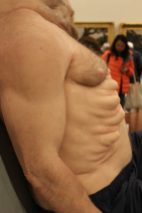







































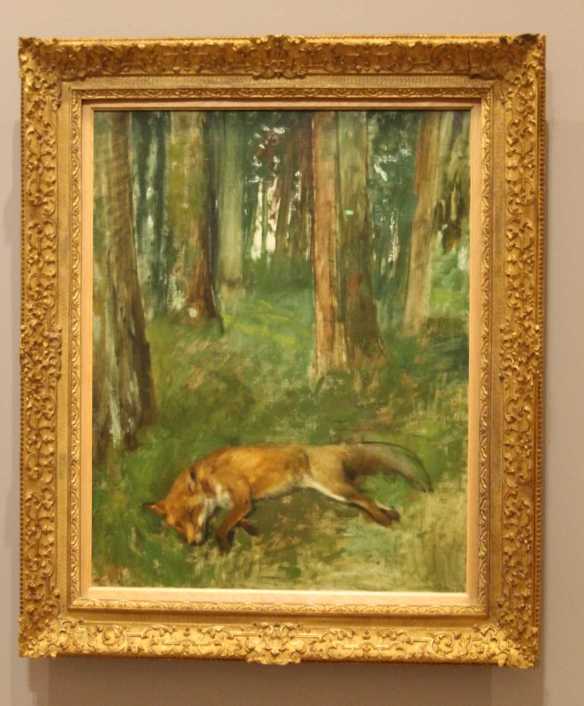

















































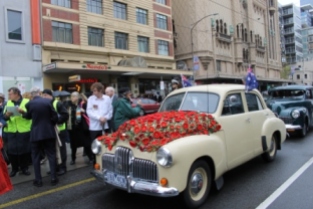
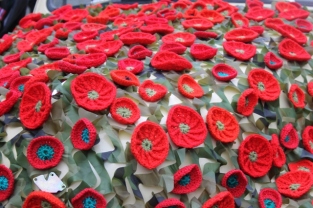




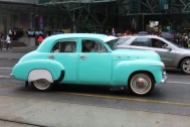



































































































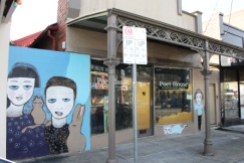








































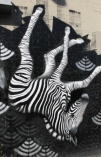






![Artist Yan Zhengxue Paiting Titled "89.6!!!! Tiananmen" Rao, M. (2014 June, 6). Huffpost Arts & Culture. Five Chinese Dissident Artists Who Aren’t Ai Weiwei. [Photo ID: courtesy Getty Images]Retrieved June 11, 2014 from http://www.huffingtonpost.com/2014/06/10/chinese-dissident-artists_n_5474258.html?utm_hp_ref=arts&ncid=fcbklnkushpmg00000027](https://idoartkarenrobinson.files.wordpress.com/2014/06/artist-yan-zhengxue-titled-89-6-tiananmen-photo-id-getty-images.jpg?w=572&h=534)



![Paulo Ito - Brazilian Graffiti Street Artist Mural Ref: Mosbergen. D. (May 21 2014). The Huffington Post. Street Artist Captures The Sheer Irony of Brazil's World Cup in Heartbreaking Image. [Photograph ID: Paulo Ito Mural]. Retrieved 5th May 2014 from http://www.huffingtonpost.com/2014/05/21/brazil-world-cup-poverty-paulo-ito_n_5362373.html?utm_hp_ref=arts&ncid=fcbklnkushpmg00000027](https://idoartkarenrobinson.files.wordpress.com/2014/05/1907658_10152410760339556_1230694933167861383_n.jpg?w=584&h=584)

![Brown. J.F. (2008, August 8). The Guardian. AFP Getty Images. [Photograph No. brownafp460]. Retrieved May 22 2014 from http://www.theguardian.com/world/2008/aug/07/china.olympics2008](https://idoartkarenrobinson.files.wordpress.com/2014/05/brownafp460.jpg?w=557&h=334)

![Chung. D. (August, 25 2008). The Guardian. [Photograph ID: rings3 1]. Retrieved May 22 2014 from http://www.theguardian.com/sport/2008/aug/25/olympics20081](https://idoartkarenrobinson.files.wordpress.com/2014/05/rings31.jpg?w=593&h=356)
![Whelan. L. (May 20 2014). Grist. Artists in China strike blows against the smog. [Photograph ID: china-piece 1]. Retrieved May 22 1014 from http://grist.org/climate-energy/artists-in-china-strike-blows-against-the-smog/](https://idoartkarenrobinson.files.wordpress.com/2014/05/china-piece1.jpg?w=554&h=738)